The Man
As we study the national park idea, many names stand out that deserve great recognition, as their efforts and sacrifices provide for the people’s enjoyment today. However, only one name truly carried the clout and political capital necessary to affect the changes required to push more than 230 million acres into protected status via the Antiquities Act… Theodore Roosevelt.
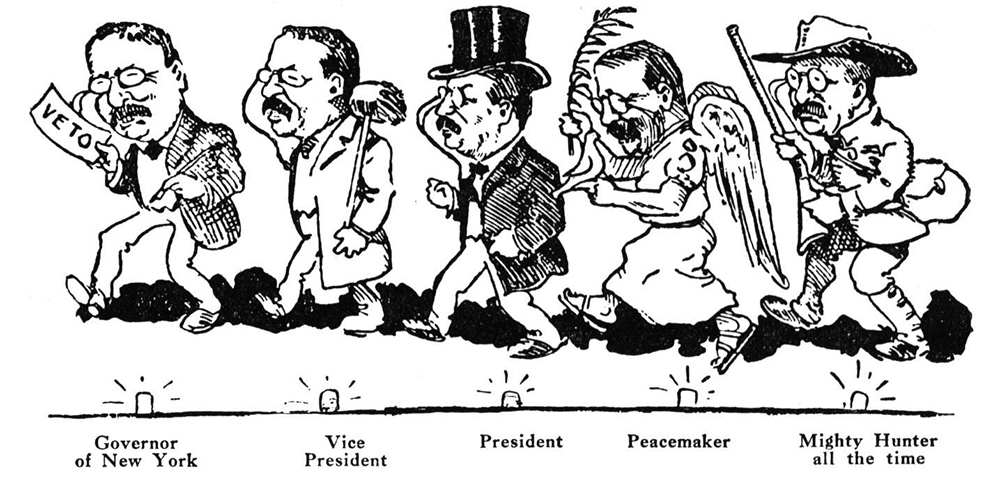
Artist – William Charles Morris / Public Domain Image*
Header Image: American Press Association / Public Domain Image*
Guide to Theodore Roosevelt
Young Roosevelt
Theodore Roosevelt entered our world on October 27, 1858, the second of four children. Born into a wealthy New York City silver-spoon family, his early years were heavily influenced by his feeble health. Young Roosevelt’s physical activities were frustratingly restricted by debilitating asthma, for which doctors could find no cure.
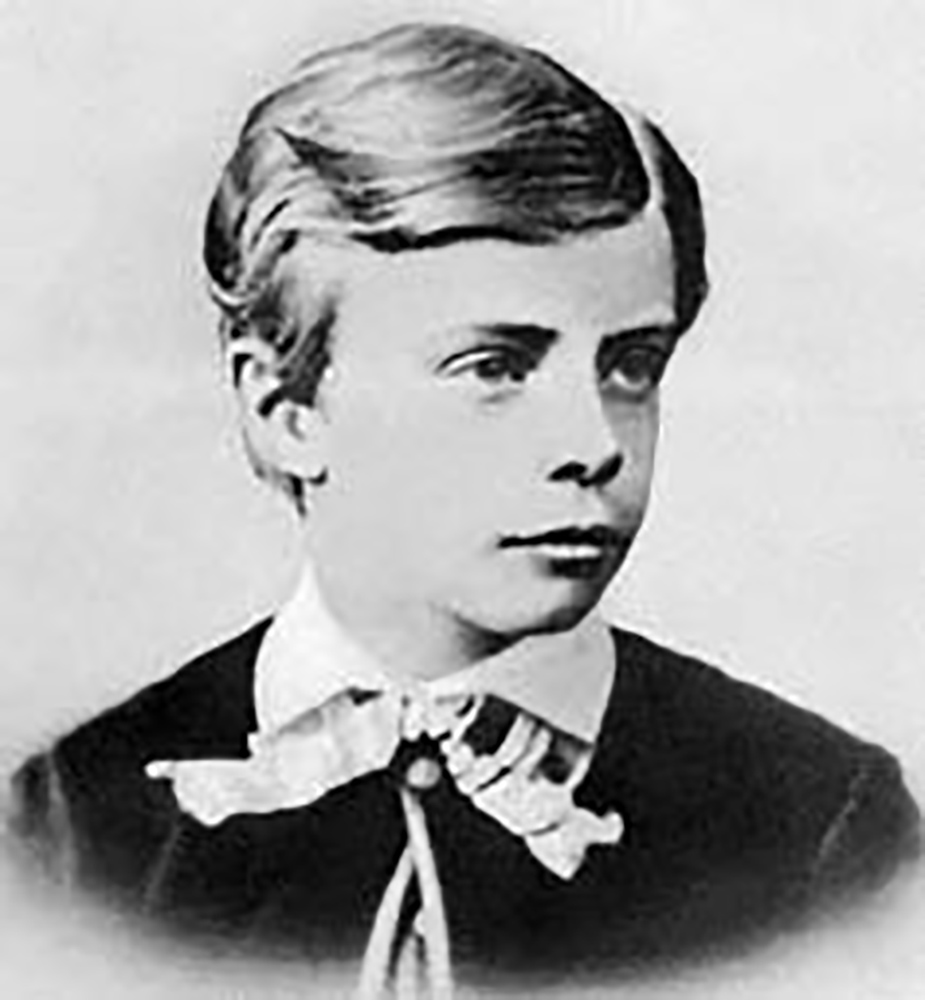
Public Domain Image
As the years passed, he discovered that he could lessen the effects of this condition through intense physical activity. The future “American Lion” began an intense regime of exercise and physical training, taking up strength development and pugilistic pursuits after finding a boxing tutor who taught him to fight effectively.
Upon conclusion of his primary education, consisting mostly of upper-class home schooling, he enrolled at Harvard University. Here he continued an intense study of biology, that had began at a youthful age and participated in numerous social and academic clubs. He also continued boxing, which would later become a required course at Harvard during World War II, while earning a degree and graduating in the summer of 1880, magna cum laude.
Roosevelt – The Author
Despite his physical debilitations, Roosevelt was a natural fighter from the beginning. In fact he was fascinated by the art of conflict. During his time at Harvard, he had begun to study the effective strategies of the U.S. Navy during the War of 1812. His examination of Naval techniques led to the publication of the 1882 publishing of The Naval War of 1812, first of many books he would write during his life.
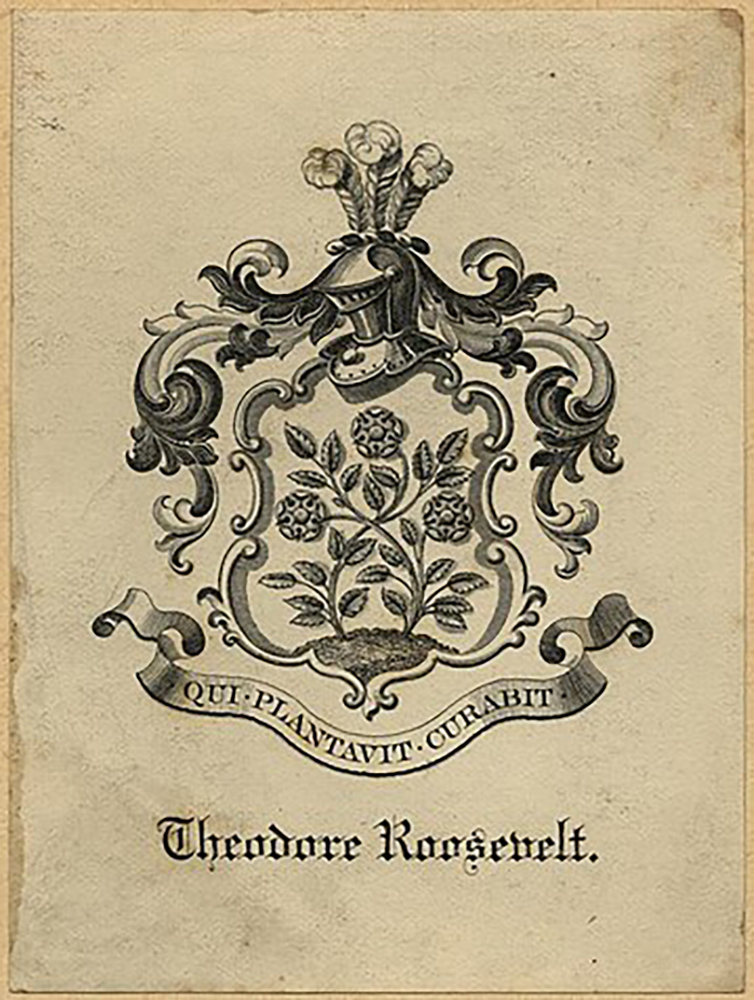
Public Domain Image
The book was quite detailed, with in-depth descriptions, charts and drawings showing naval ship maneuvers, cannon strengths and reviews of those commanding the ships. The book received rave reviews, later becoming required reading at the U.S. Naval Academy in Annapolis, Maryland.
Roosevelt went on to enroll in the Columbia School of Law in the winter of 1880. He proved quite capable in this study, but found the curriculum to be somewhat mundane, in fact, irrational. He soon abandoned his study of law to pursue emerging political ambitions, entering the New York state legislative body as an assemblyman in the Republican Party in 1881.
Alice Hathaway Lee
In the fall of 1880, between his time at Harvard and Columbia, Theodore married Alice Hathaway Lee, a New York socialite with whom he had fallen in love despite her initial reservations. Their engagement was announced on Valentine’s Day, 1880, and they were married on October, 27, 1880, Roosevelt’s 22nd birthday.
Throughout these years, Roosevelt continued his lifelong dedication to strict physical training and augmented his exercises with various outdoor pursuits, such as a climb of the Matterhorn in 1881 while vacationing in Europe. The following year, he began to plan what would be one of the most influential trips of his life, to the wild west and the unknown Dakota Territory, in search of the fabled bison.
Roosevelt – The Hunter
In the fall of 1883, Roosevelt entered the town of Little Missouri, in the Dakota Territory where he quickly hired 25-year-old Canadian Joe Ferris as a hunting guide. The wealthy easterner and his newly found guide set out to kill one of the few remaining bison that still roamed free among the rolling grassy hills that would later become home to a national park bearing his name.
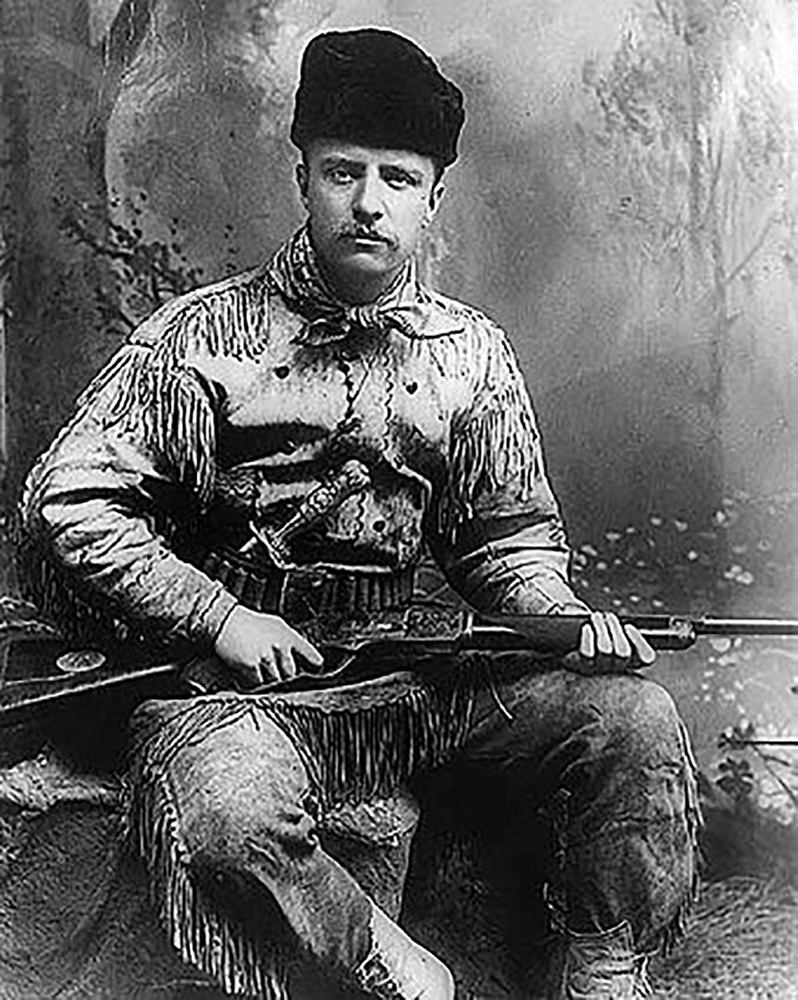
Photographer: George Grantham Baine – 1885 in New York / Public Domain Image
The mission proved to be more difficult than Ferris or Roosevelt anticipated. The bison’s numbers had entered a rapid decline due to the commercial slaughter of the region’s herds over the recent years. Ferris appeared to be somewhat exhausted by his client’s spirit and unwavering determination to find his prey.
When not hunting or sleeping out on the land, the men were using a small ranch cabin, owned by local rancher Gregor Lang as base camp. Evening discussions between Roosevelt and Lang were lengthy, ranging from political issues to military strategy, ranching and western life. Ferris often would adjourn early to rest up for the next day’s hunt, while Roosevelt and Lang gabbed late into the night.
Roosevelt – The Rancher
While in the Dakotas, Roosevelt became fascinated with the area and its rugged nature. So much so that he immediately deposited $14,000, partnering with his hunting guide’s brother Sylvane Ferris and a gentleman named Bill Merrifield to purchase what became the Maltese Cross Ranch at Chimney Butte. It was decided that the partners would act as managers of a newly formed cattle ranch operation in TR’s absence

Photo- Library of Congress
After a mere two weeks in the Dakotas, he now owned a ranching operation and a piece of the fabled Dakota territory, not to mention a prized bison head, which was his only goal during the short visit. The bison’s head today adorns a wall at Sagamore Hill National Historic Site, in NYC, Roosevelt’s home from 1885 until his death in 1919.
With such deeds now accomplished in the Dakotas, the young politician returned to New York to get back to work.
Unspoken Tragedy
The following spring brought the birth of a daughter to he and his beloved wife Alice. Celebration of this birth was to be short-lived unfortunately, as his mother, “Mittie” passed away two days later, of typhoid fever. As fate would have it, his wife Alice would die later on that same Valentine’s Day, of an unforeseen kidney failure, symptoms of which were masked by the pregnancy.
Roosevelt’s journal entry for that horrible February day was simply a large “X”, followed by the words, “the light has gone out of my life”.
To our knowledge, he never again spoke of his wife, Alice Hathaway Lee Roosevelt. He destroyed all correspondence that even made reference to her. Reportedly, he never even spoke of her in conversations with their daughter, Alice Lee Roosevelt. It appears he attempted to effectively erase her, and her death, from his mind.
Following the death of his wife and mother, Theodore finished up some political business, attending the Republican National Convention, in Chicago, and headed back to the Dakota Territory to find relief from great sorrow.
Back to the Dakotas
During his second trip to the Dakotas, Roosevelt realized that his Maltese Cross Ranch was not quite remote enough for his liking during his time of mourning. He soon found an area that offered greater solitude, about 35 miles north of the Maltese Ranch. Here he established what he would call the Elkhorn Ranch.
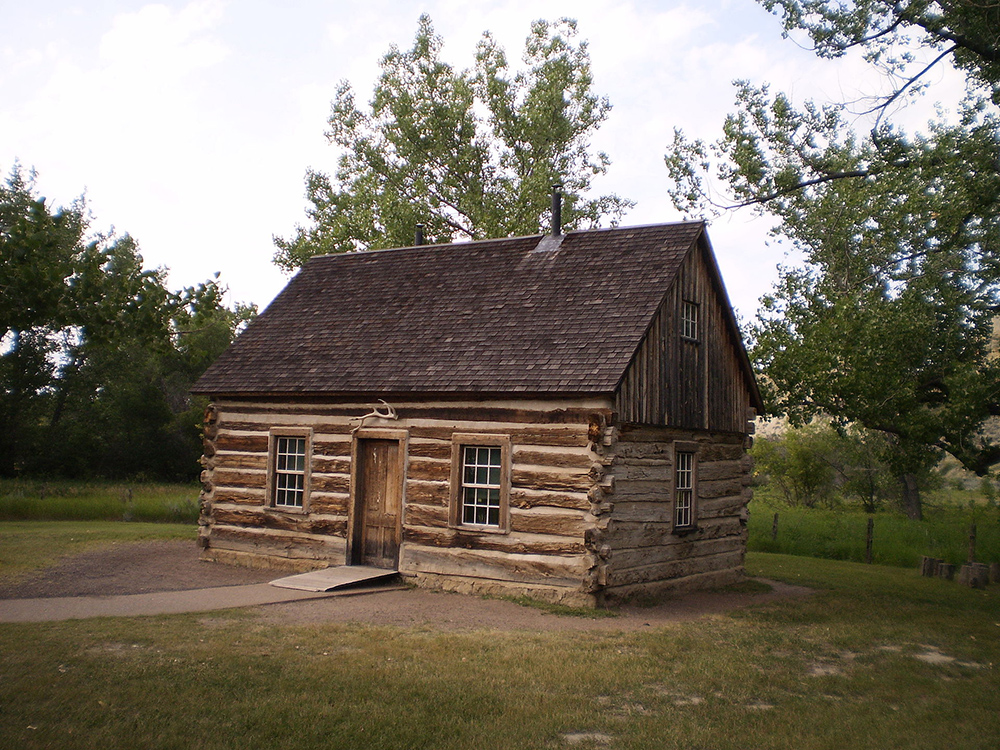
Public Domain Image
Soon, he recruited two buddies from Maine, Bill Sewall and Wilmot Dow, to come and build a suitable ranch house that would be his Dakota home. These men would also act as managers here when the young politician was serving the public in New York.
Roosevelt stayed in the Dakotas for much of the remainder of 1884. He returned to New York briefly to work on a Republican presidential campaign in the fall, however promptly returned to the Elkhorn ranch upon completion of his political duties.
The next year found the future president on the Elkhorn Ranch much of the time, writing a second book, this one about ranching and hunting in the Dakota Territory. He helped organize a cattleman’s association in the area and participated in numerous cattle drives and roundups.
The Boxing Days Pay Off
The emerging powerhouse even found himself in a small town bar fight with a gun-yielding bully who referred to Roosevelt as “four eyes” in what is today, Montana. He even wrote about it in his journal, detailing the altercation as if it was an action novel.
“As I rose, I struck quick and hard with my right, just to one side of the point of his jaw, hitting with my left as I straightened out, and then again with my right. He fired the guns, but I do not know whether this was a convulsive action of his hands, or whether he was trying to shoot at me. When he went down he struck the corner of the bar with his head… if he had moved I was about to drop to my knees; but he was senseless. I took away his guns, and the other people in the room, who were now loud in their denunciation of him, hustled him out and put him the shed”…

Library of Congress Photo
Roosevelt straight knocked this guy out!
How many of our modern era presidents can claim such badassary…?
(crickets….)
Edith Carow
Over the following decade, Roosevelt would travel back and forth between the Dakotas and New York at least annually, managing his political career and the cattle operations with his partners at the Dakota Ranchs. Long expeditions and hunting trips were common for the man during these years, but he also found time to enter a new love affair.
In late 1885, back in New York, he began a secret courtship with his childhood sweetheart, Edith Carow, whom would become his second wife in December of 1886 during a secret ceremony in London. The couple’s first son, Teddy Jr, was born in September of 1887 at Sagamore Hill in New York.
Boone and Crockett Club
Although his cattle operations proved largely unsuccessful due to harsh winters and bad luck, his political capital increased rapidly during the following years and all-the-while he continued to travel and hunt in the west. In 1887, he helped establish the Boone and Crockett Club, a fair-hunting club, and in 1890, he visited his first national park, on a trip to Yellowstone with his wife Edith, after a visit to Elkhorn.
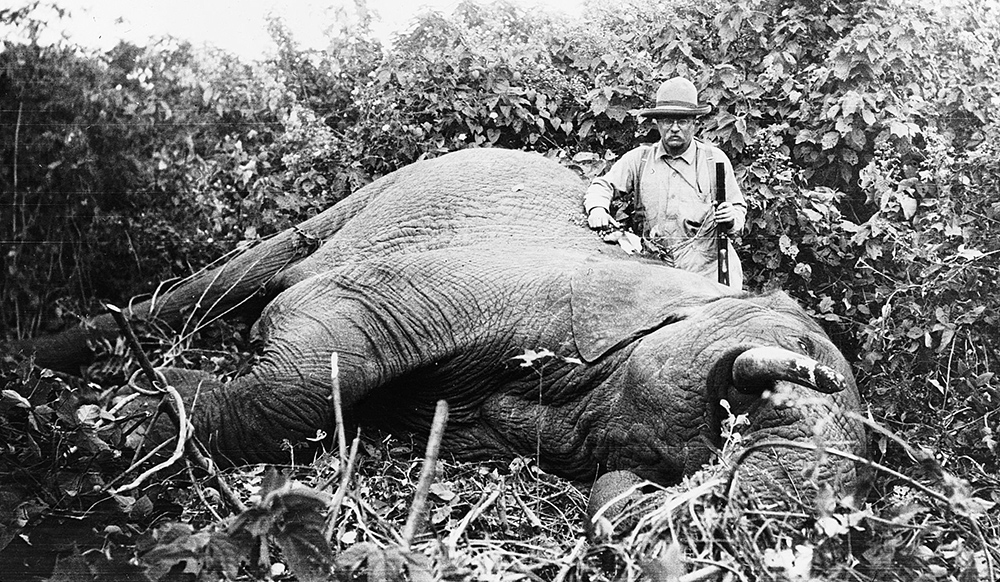
Public Domain Image
Meanwhile, he published numerous books detailing his ranching and hunting exploits in the west, biographies of various political figures, essays on political philosophy, and a number of historical novels describing the histories of New York and the American West, as well as tales of various heroes in American History.
Roosevelt – The Soldier
In 1898, President William McKinley appointed Roosevelt as the Assistant Secretary of the Navy and thus continued his prominent rise on national political scene. The following year, the Spanish-American War broke out and Roosevelt resigned his post in the Navy to join the 1st U.S. Volunteer Cavalry Regiment, receiving a Lieutenant-Colonel commission.
Roosevelt, with Army Colonel Leonard Wood, promptly formed the “Rough Riders” a temporary unit of hardcore dudes that would serve only for the duration of the Spanish American War. Training began immediately and soon, Roosevelt and his band of Rough Riders were headed to war in the jungles of Cuba. He was 30 years old…
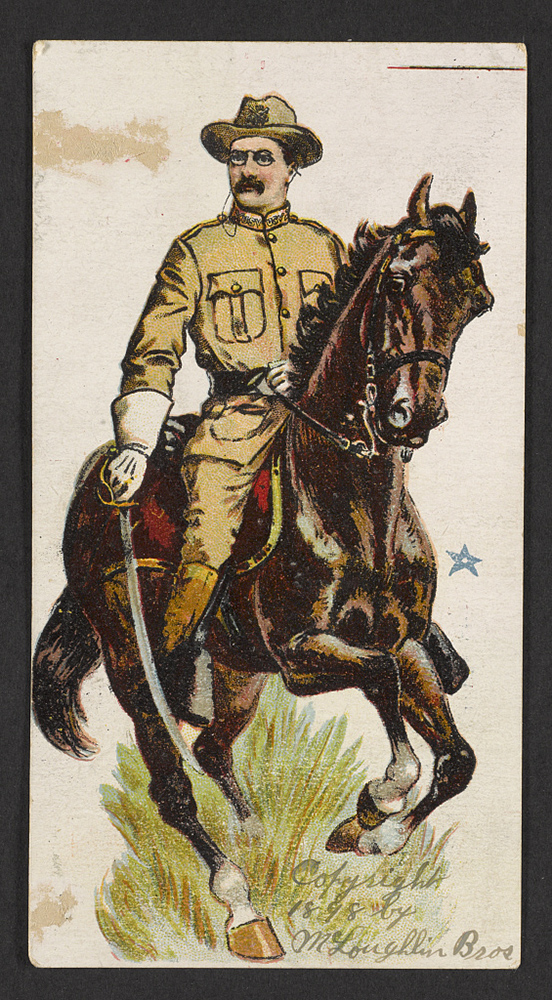
Image-Library of Congress
Due to rampant disease in the jungles, many superiors soon fell aside. Roosevelt was quickly promoted to full Colonel. The Rough Riders proved to be a deadly band of soldiers at the battle of Las Guasimas, and later at San Juan Hill, where Roosevelt effectively overruled another Colonel’s orders to stand down.
Battle of Kettle Hill
Recognizing that he and his men were sitting targets for snipers above, and were likely doomed if definitive action was not taken, Roosevelt, atop a horse named Texas, ordered and led a charge up Kettle Hill. Assisted by a spray of cover fire by 3 Gatling guns that sent some 18,000 rounds into the Spanish trenches, he and his men took the hill in twenty minutes.
Kettle Hill proved to be a key to victory in the San Juan Heights. The taking of San Juan Hill provided U.S. troops an advantageous point from which to lay siege to the city of Santiago, the stronghold of the Spanish Army. This led to a rapid end to the Spanish American War. After a campaign that lasted less than two months, Roosevelt and his Rough Riders came home.
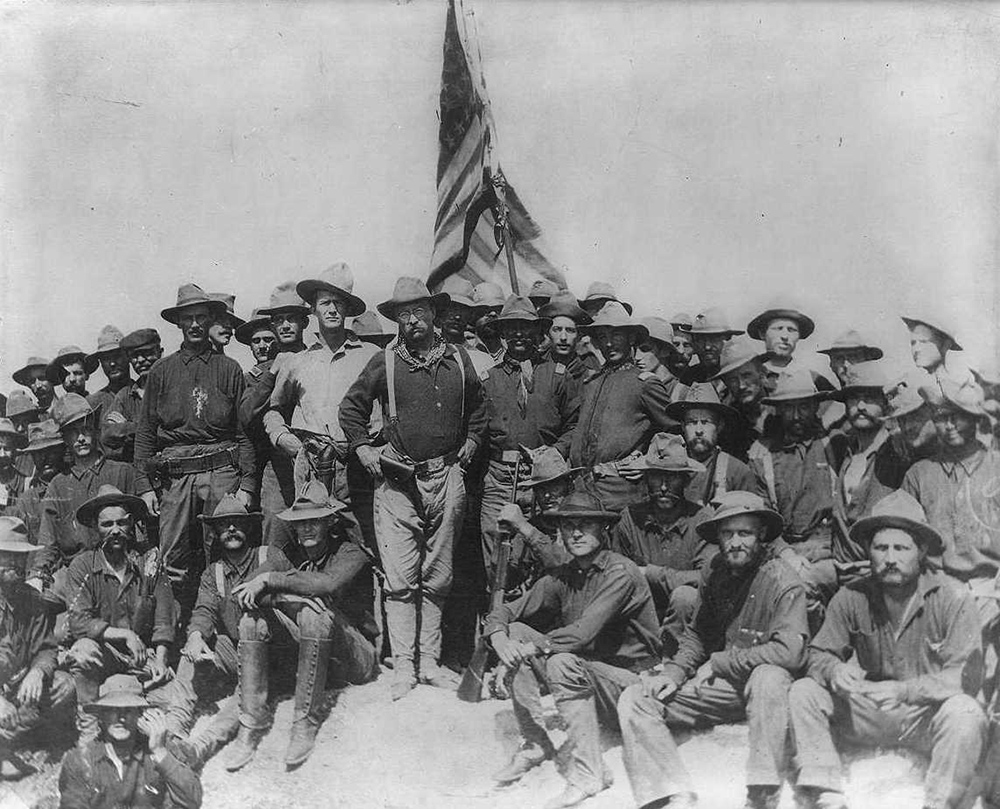
Public Domain Image
Upon his return from Cuba, Roosevelt was something of a star. He referred to The Battle of Kettle Hill as “the great day of my life” and for his actions there, he was posthumously awarded the Medal of Honor in 2001.
One thing should be abundantly clear as we sum up his military contributions; Theodore Roosevelt was in no way compelled to head into battle out of financial hardship, or due to being ordered to do so. His participation in the war effort was due solely to his desire to take part in battle. To get his hands dirty. To be a man. To make a difference. To get into the action. Perhaps to kill… Perhaps for glory… Perhaps for ego…
No matter the reason for his voluntary involvement in this endeavor, one thing is obvious to the student of history. Theodore Roosevelt was definitely not a sideline player…
Roosevelt – The Politician
His post-war popularity led Republican officials to recruit him for the New York’s highly contested 1898 gubernatorial race. He accepted the nomination, and won… 1898 was a big year for Theodore, or “The Colonel” as he now preferred to be called. August found him on the battlefield, and November found him to be governor of the State of New York.

Artist-B.J. Falk / Public Domain
During his time as governor, Roosevelt groomed his political skills and became more concerned with the issues of economics and trusts, along with the growing monopolistic structures that were growing in large industry at the close of the 19th century.
His concerns regarding corporate behaviors and the public responsibilities that he felt they were sidestepping became the backbone of what would later shape many of his policies during the trust-busting maneuvers devised during his presidency.
Roosevelt – The Vice President
Despite Roosevelt’s popularity, there were many detractors that feared what he may do if he gained real power. It was becoming obvious that the New York Governor despised the big-business insiders that controlled large oil and rail monopolies in the 1890s.
With this in mind, the power-players in these industries and their friends in high-level politics moved to handcuff the rising political star… what better way than to place him in a relatively powerless position… that of Vice President of the United States.
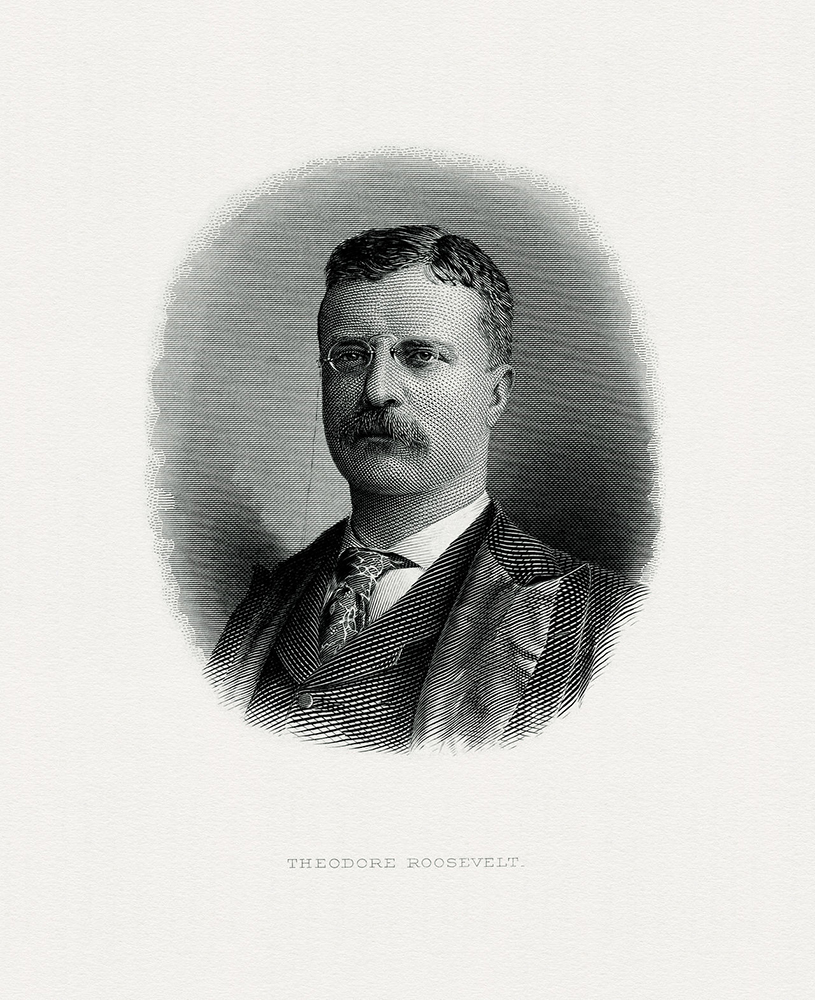
Public Domain Image
In the re-election campaign of President William McKinley in 1900, the recent death of Vice President Garret Hobart left an open spot on the ticket. Roosevelt had pondered a presidential run, but thought it unwise to challenge McKinley, and thus considered a later run, perhaps in 1904. The powers-that-be however, found a way to place him in the Vice Presidential position.
At the 1900 Republican National Convention, Roosevelt, although reluctant to take a stagnant position, agreed to become the Vice Presidential candidate aside McKinley.
Roosevelt proved to be a powerhouse on the campaign circuit and provided a thrilling adversary to the active campaign of Democratic candidate Williams Jennings Bryant, who was constantly on the move in the heat of the campaign.
Roosevelt made more than 480 campaign stops in 23 states that year and focused upon his record as a war hero. America listened. America liked Teddy. And America elected McKinley to victory by an even larger margin that it had four years earlier.
The position of Vice President was essentially a holding tank. Roosevelt had no real power, aside from casting a tie-breaking vote in the Senate, which never happened. Life was tranquil and eventless… not really his style, but he traveled, vacationed, boxed, wrote and read…
McKinley’s Assissination
Then, on September 6, 1901, history was written.
President William McKinley was shot twice by an assassin at the Pan-American Exposition in Buffalo, New York. Roosevelt was vacationing in nearby Vermont, and was alerted to the news. He rushed to Buffalo where he met with the President.
It first appeared that McKinley would recover, so Roosevelt returned to his vacation. However, McKinley’s condition was not to improve, he died from complications suffered as a result of the gunshots on September 14, 1901.
Roosevelt – The 26th President
Roosevelt returned to Buffalo immediately and later that day, was sworn in as the 26th President of the United States in the home of his friend, Buffalo attorney Ansley Wilcox. Today, this home is the site of the Theodore Roosevelt Inaugural National Historic Site.
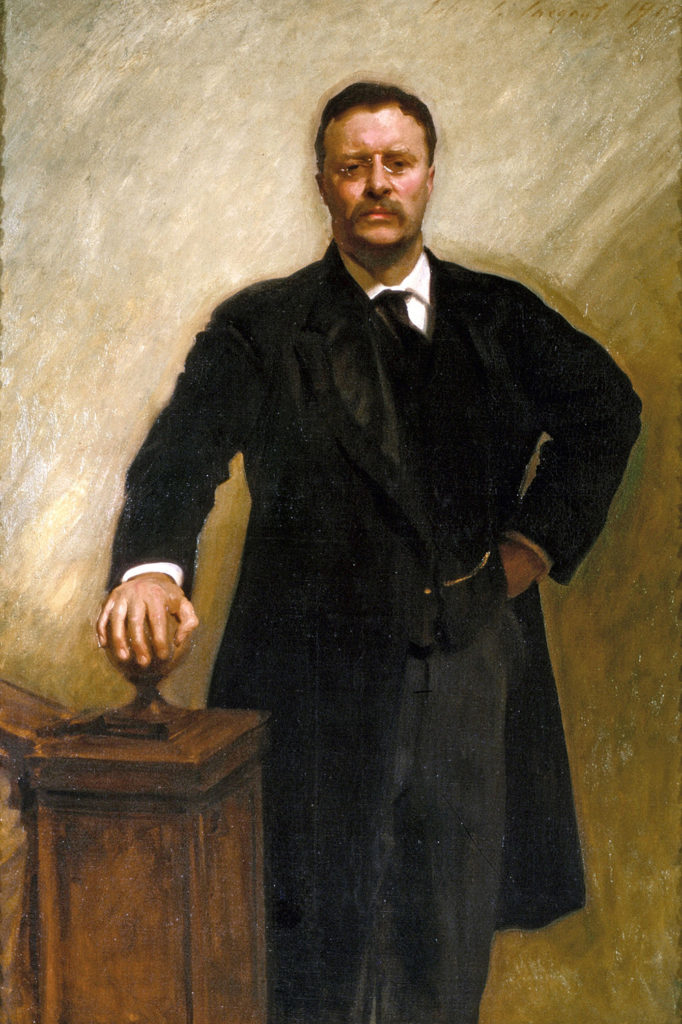
Artist-John Singer Sargent / Public Domain Image
The weakly boy who once struggled to breathe, the same boy who went west to kill a bison, who’s young dying wife languished in his arms while he helplessly held her, who restlessly wandered alone on the plains of the badlands mourning her loss, and who fought bravely upon the hills and amid the jungles of a foreign land, was now President of the United States of America…
Roosevelt – The Trust Buster
Roosevelt is widely remembered as the “trust-buster” for his regulation of industry and the separation of monopolies such as Standard Oil, along with his regulation of railway rates, food and drugs, the meat packing industry and according to his detractors, regulation of “everything from the birth of Christ to the death of the devil”….
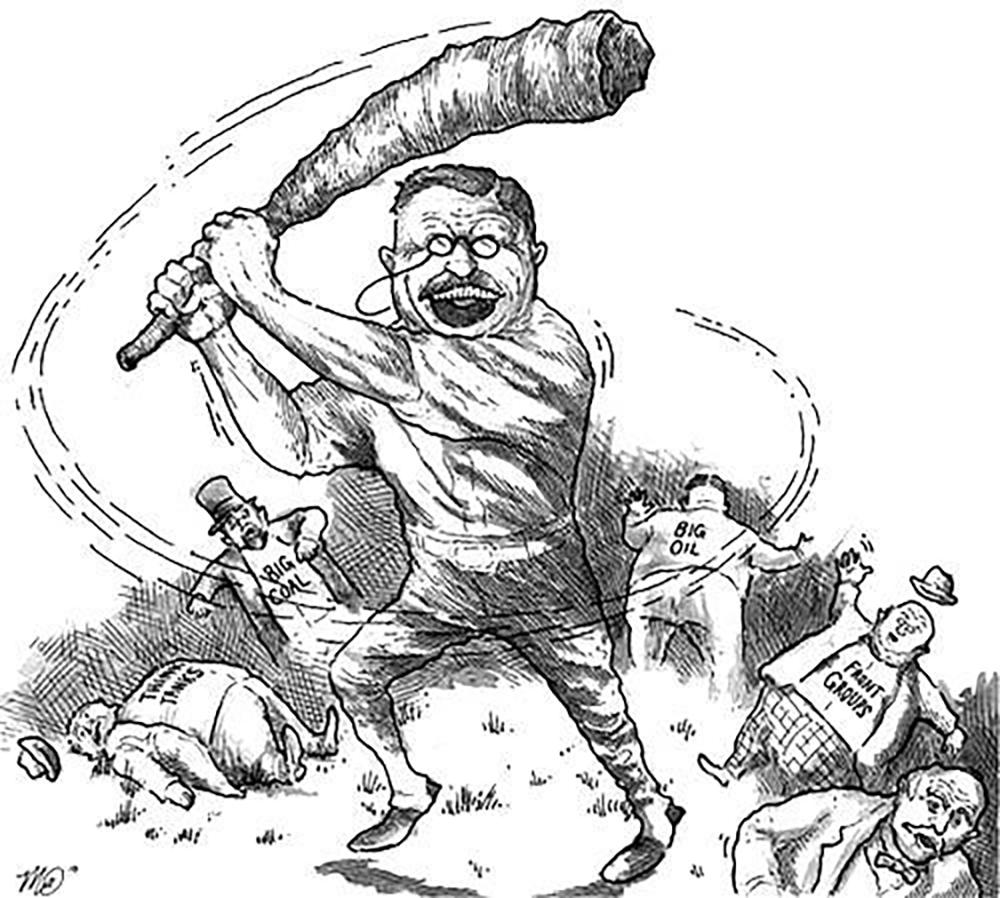
Public Domain Image
While it is true that he made moves to reign in runaway corporations with a record 44 antitrust suits during his tenure as President, and his efforts to secure labor rights for workers provided a “square deal” for the working man, his proudest moves were in the area of public land preservation, and that is precisely why this piece has even been written.
The Antiquities Act of 1906
During the late 19th century, American expansion into the west began to lead to the looting of many native and historical sites. The effects were concerning to preservationists who were alarmed at the rate of removal of objects from locations such as Mesa Verde and Petrified Forest, and many others throughout the remote areas of the west. Roosevelt was not unaware of these problems and became involved.
Roosevelt became a boss in his appetite for conservation, signing the Antiquities Act during his second term in 1906, which allowed the President to designate National Monuments, for “the protection of objects of historic and scientific interest.” In September of 1906, Roosevelt took immediate advantage of the Act with a move to designate Devil’s Tower as the nation’s first national monument.
Roosevelt – The Conservationist
The remainder of his term resulted in an astounding number of protected lands. With “The Colonel” at the helm, our nation created 5 national parks, 18 national monuments, and 51 federal bird reserves that would later become national wildlife refuges. Today, 8 of these areas are now national parks.

Public Domain Image
His protected areas amass a total of more than 230 million acres of public land, some 150 million of which were part of the newly created National Forest Service, which was placed under the leadership of land use architect Gifford Pinchot and the Department of Agriculture in 1905.
Roosevelt was responsible for the creation of more land preservation sites than any other president until the administrations of Bill Clinton and Barack Obama surpassed his totals in the late 20th and early 21st centuries.
While we may not all agree on the policies of individual politicians, Roosevelt included, we must admit that our land preservation movement today would likely be less effective without his original bravado and guidance of. Quite frankly, if you are involved in any outdoor pursuit in nearly any area of the American West, it is highly likely that the land upon which you enjoy your days is available to you due to the efforts of this man. And for that, we must be grateful….
Roosevelt – The Bull Moose
As we can deduce from this brief and vastly incomplete overview of his life, Theodore Roosevelt was a Bull Moose of a man. Indeed, he said so himself, after being shot in the chest by a would-be assassin at a public speaking event during his attempted return to the Presidency in 1912.
President William Howard Taft had taken over the reigns in 1908, following Roosevelt’s second term. His policies toward business and economic interests did not follow the trajectory that Roosevelt had envisioned. This led Roosevelt to attempt to regain the Republican Presidential nomination from Taft at the convention.
The Republican Party, somewhat surprisingly, remained loyal to Taft, leading Roosevelt to form a third party to challenge both Taft, and Democratic nominee Woodrow Wilson. The party he formed was called the Progressive Party, but is better known today as the Bull Moose Party.
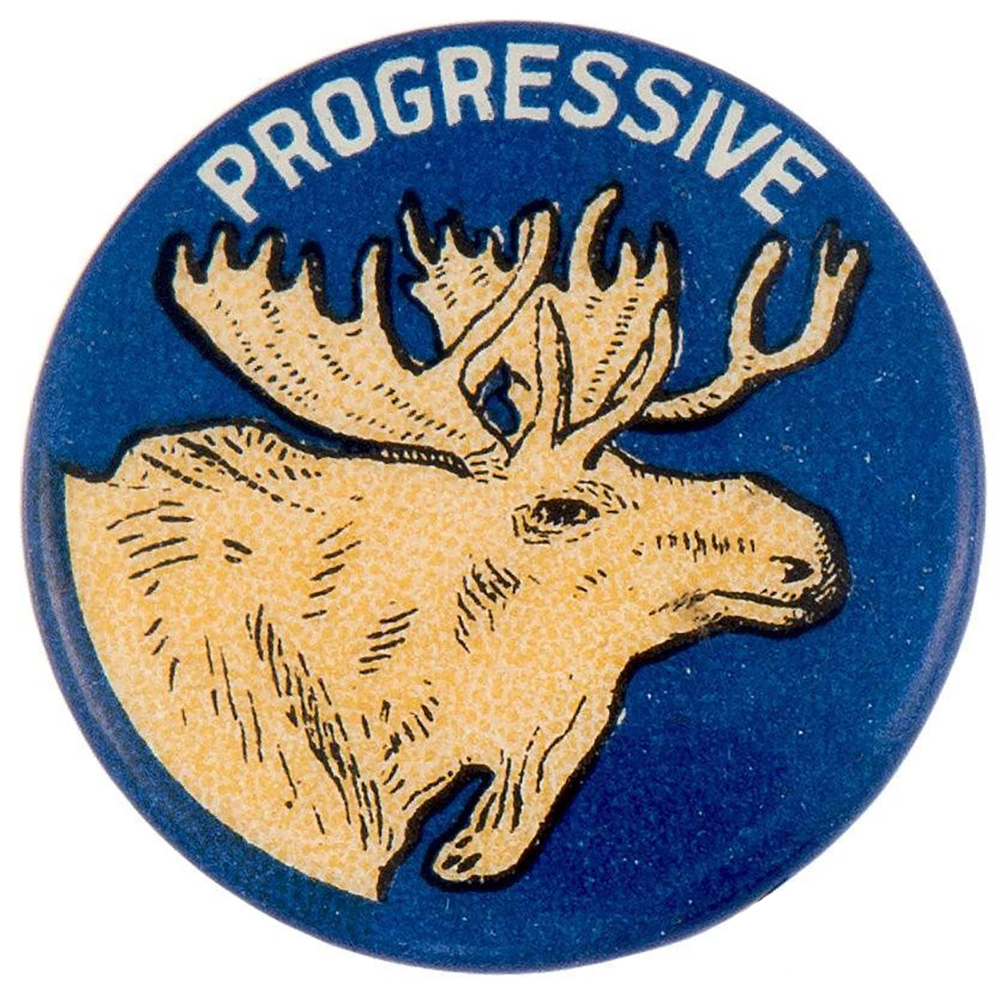
The scene was Milwaukee, Wisconsin. The campaign for the Presidential election was heated as Roosevelt had returned to the political arena in an attempt to oust his protege, incumbent Republican President, William Howard Taft, whose inefficacy in office had raised the ire of Teddy, who had basically hand-picked for the job a mere four years earlier. On the other side of the isle was Democrat Woodrow Wilson, President of Princeton University and a newcomer to the political stage.
Roosevelt was to take the stage before a Milwaukee crowd on a brisk October afternoon and deliver his 50-page speech, “A Progressive Cause Greater Than Any Individual”. The speech was folded in the breast pocket of his jacket, where he also held his metal glasses case.
Shot in the Chest
As Roosevelt left the Hotel Gilpatrick on his way to give the speech, a saloon-keeper named John Flammang Schrank produced a .38 caliber revolver and shot Roosevelt point-blank in the chest. The bullet penetrated the glasses case and the speech, which since folded was 100 pages thick, then entered the ex-President’s chest.
The surrounding crowd mobbed the would-be assassin and immediately wrestled him to the ground and would likely have delivered substantial injury to Schrank had Roosevelt not quickly recovered from the attack and ordered that no harm come to the man who had attempted to end his life. Police removed Schrank.
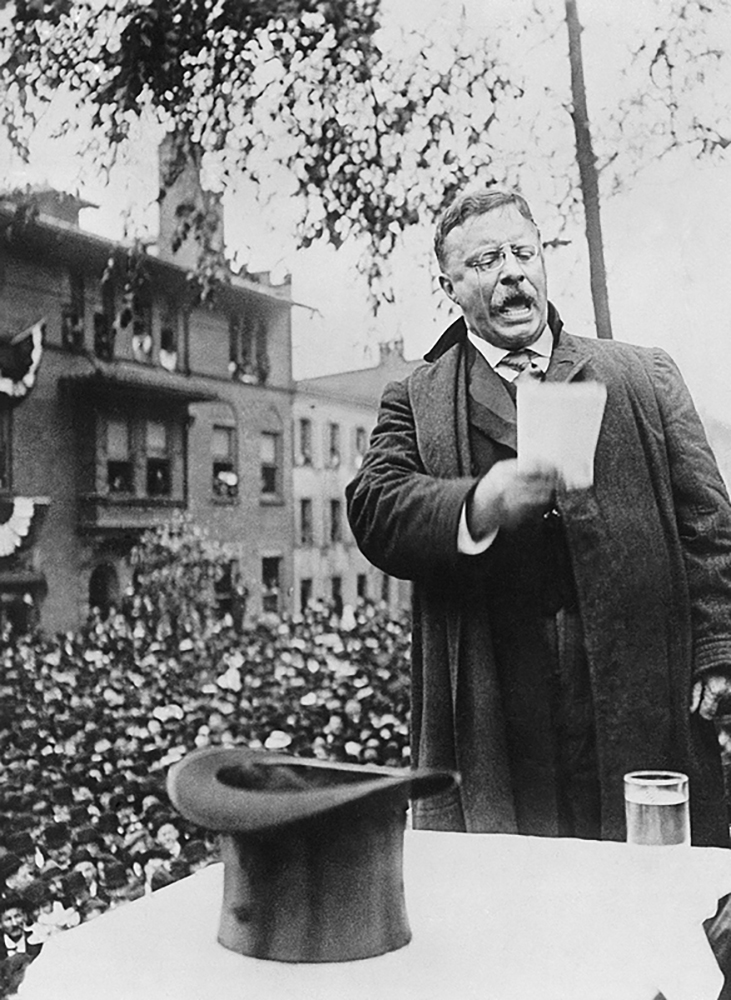
Public Domain Image.
Roosevelt reached under his jacket and felt blood. He induced coughing and spat in his own hand to determine whether the bullet had reached his lungs. Being reasonably familiar with anatomy thanks to his time hunting big game, seeing no blood in his spit, he determined that he was able to go on, declining the pleas of aids and bystanders to go to a nearby hospital.
The Speech Goes On
In a feat that is sadly, absolutely unfathomable today, our man Teddy continued to the auditorium where he delivered his speech. He pounded his fist in his hand and as he revealed to the audience the foiled assassination attempt:
“Friends, I shall ask you to be as quiet as possible. I don’t know whether you fully understand that I have just been shot; but it takes more than that to kill a Bull Moose. But fortunately I had my manuscript, so you see I was going to make a long speech, and there is a bullet — there is where the bullet went through — and it probably saved me from it going into my heart. The bullet is in me now, so that I cannot make a very long speech, but I will try my best.”
The man, a former president, went on to give a political speech that lasted nearly 90 minutes… with a bullet in his chest…
Where are you today TR…? Where are you today….?
Guide to Theodore Roosevelt
Relevant Links
National Park Guides

All content found on Park Junkie is meant solely for entertainment purposes and is the copyrighted property of Park Junkie Productions. Unauthorized reproduction is prohibited without the express written consent of Park Junkie Productions.
YOU CAN DIE. Activities pursued within National Park boundaries hold inherent dangers. You are solely responsible for your safety in the outdoors. Park Junkie accepts no responsibility for actions that result in inconveniences, injury or death.
This site is not affiliated with the National Park Service, or any particular park.
